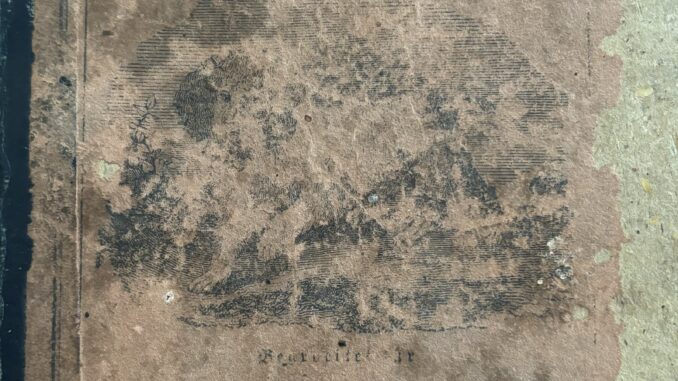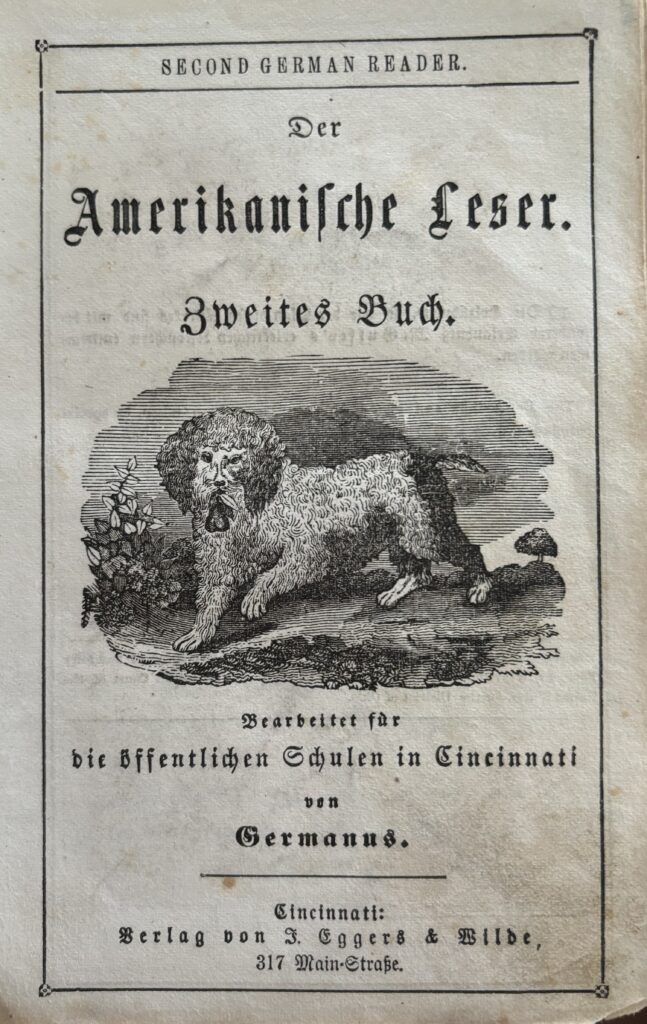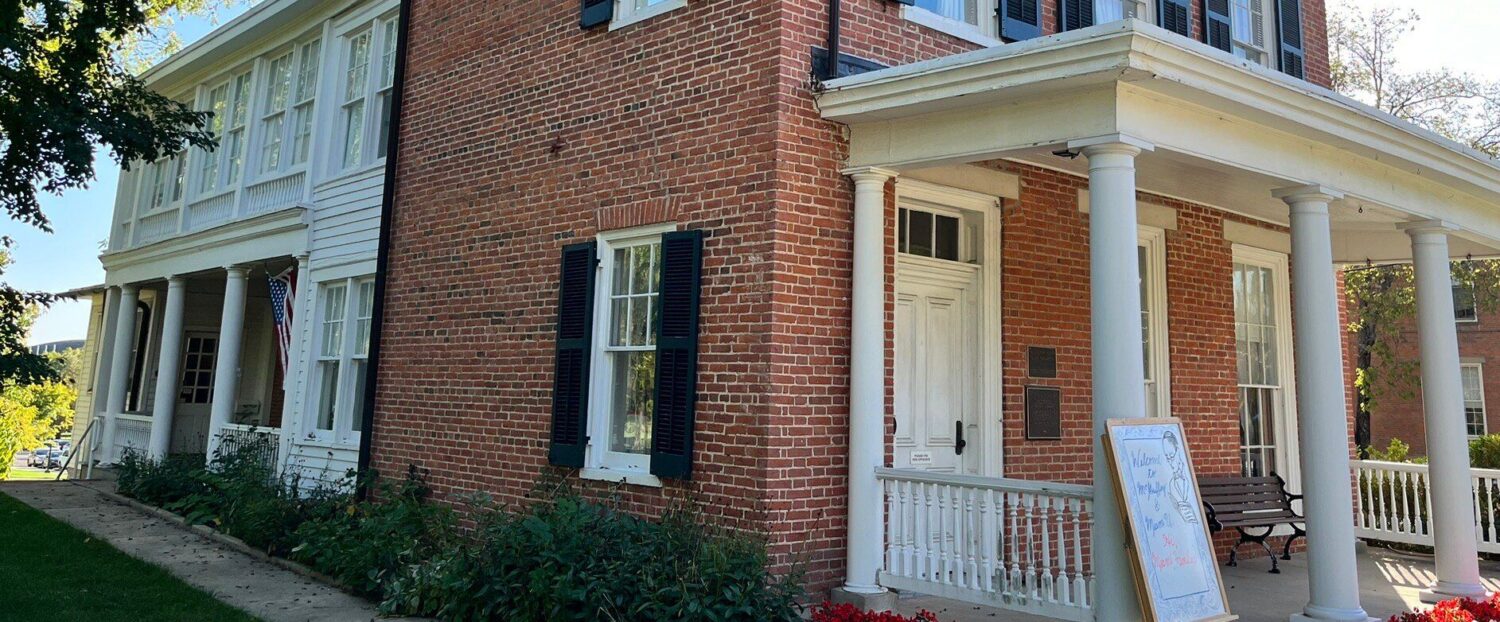
By Hope Nickel
Walking into the McGuffey House and rounding a few corners into the library, you may notice a reader that doesn’t look like the rest. That’s because when you go to read it, you’ll be greeted by a book written in German rather than English. The collection of McGuffey’s Eclectic Readers held by our museum is one of the largest in the world, and the relatively unique holding of a German version of the Readers reflects that.
Our copy of the second book in the Amerikanische Leser (“American Reader”) series–otherwise known by the English-speaking individual simply as the German Readers series–reveals to us some of its history directly. The front cover and first pages of the book reveal that the author is anonymous. At best, we know that it was written by someone who used “Germanus” as a pseudonym. Beyond that, though, many more people were involved in its creation. Winthrop B. Smith holds the copyright, J. Eggers & Wilde published the piece, and C.F. O’Driscoll stereotyped the book. Winthrop B. Smith was involved extensively in the creation of McGuffey’s Readers, being their publisher and eventually owner to the works’ rights. We also know that the book was “prepared for the public schools of Cincinnati,” according to its title page, and published in 1854.
That said, the following text investigates the growth and prominence of German immigrants in Cincinnati and their influence on the city’s school system that caused the birth of this reader we have in our possession now.

German Immigration to the United States
German immigration to the United States started as early as any other European colonization to the North American continent. The wave of Teutonic travelers to the States, though, surged first in the 1850s as a result of the failed 1848 revolutions in Europe. About one million Germans immigrated to the United States in the decade. Germans flourished in the country, owning breweries, joining the military, publishing newspapers in their native language, and more. Still, they experienced their share of xenophobia and nonetheless could be suppressed for their foreign identity.
Cincinnati was one corner of the “German triangle” of major cities that Germans fled to in the country, with the other two corners of the triangle being St. Louis and Milwaukee. Cincinnati specifically was a popular destination for German immigrants based on a combination of factors, all of which can be attributed to Cincinnati being regarded as the booming Queen City of the West at the time. For example, there were many jobs in the popular industries of meatpacking and shipping available for the immigrants, but there were also many skilled Germans who filled positions in more specialized industries, such as brewing and tailoring. As more Germans arrived, the relatively inexpensive housing north of the Miami and Erie Canal–among other factors–caused the Over-the-Rhine German enclave to be created in the northern region of the city. By 1850, at least 60% of Cincinnati’s population was German.
German Schools and Language in Cincinnati
Along with the Germans came their language. Many areas of public life in Cincinnati used the German language as their means of communication. German was used in newspapers, banks, stores, churches, schools, and more. As the front cover of the Amerikanische Leser tells us, there were even public schools in Cincinnati that taught German by 1854, the year this reader was published. How did the incorporation of German into the city’s public school system come about?
It is first important to understand the German values, concepts, and efforts regarding education that were imported alongside language. Concepts such as kindergartens and gymnasiums that are in American schools today come from German ideas. Other German ideas on education that are expressed in the saying “was Hänschen nicht lernt, lernt Hans nimmer” (“what young Hans doesn’t learn, Hans never learns”) also influenced the curriculum of Cincinnati public schools to put an emphasis on intensive learning for young students.
Long before German was introduced to the city’s public school system, German immigrants made their own schools for their children with German as the primary language. Going back to the colonial age of America, the German settlers created the largest number of schools compared to any other non-English ethnic group, with most of such institutions conducting their classes exclusively in German and as parochial schools. However, German slowly started to melt into the predominantly English-speaking country as German schools became obsolete with the rise of German-English schools.
The first truly German-English school in Cincinnati was created in 1835, that being the German-English Primary School of the Catholic Church on West Fifth Street, which taught German to students every day. A few years later in 1840, Section 4021 of the Ohio Statutes passed and provided for the formal and encouraged implementation of German in Ohio public schools. Two more Cincinnatian German-English schools opened in 1840 alone by this statute. However, the Cincinnati Board of Education at this time treated German education adherents with ignorance and sometimes outright discrimination.
Despite the wants of the German community, German-English schools prepared German-speaking students to enter English-speaking schools as a form of assimilation. Rather than using this transition to completely erase younger generations’ connection to German, the language’s diffusion into the public English-speaking school system in the form of new German departments grew throughout the 1850s, replacing the German-English public schools. Even as early as 1845, the more liberal-minded Cincinnatian came to appreciate teaching German to the average public school student and not just to German children. This book in particular seems to be published in response to the 1852 outcry from the German community to standardize and better the German curriculum in public schools, of which there were actions taken by the School Board to do so in the fall of 1853.

Repression and Revitalization of the German Language in Cincinnati and its Schools
While discrimination in Cincinnati against Germans and their culture existed for many decades before World War I–perhaps reaching its fever pitch with the Riots of 1855 between nativists and German-Americans–it was the era of this global war that ultimately caused the downfall of German instruction in schools. While there was a valiant and uniquely strong fight to retain German instruction in schools during the First World War, Cincinnati ultimately folded.
Pushes to eliminate German instruction was one victim of the “selective hysteria” observed by Cincinnatians towards German culture as a result of the war, which caused the ban of German to escalate across Cincinnati public schools starting in February 1918. Additionally, most or all of the remaining Cincinnati-based private German-American schools closed during the war. By 1919, the Ake Law banned all German instruction below grade eight for the entire state of Ohio, but despite this period of restriction, German instruction returned to Cincinnati public high schools in 1926.
After a period of repression, German began to flourish again in Cincinnati schools with the opening of the German-English Bilingual Alternative School in 1974. The legacy of a strong and pervasive German culture in Cincinnati lives on in present-day examples, like the Fairview-Clifton German Language School, and reminders of the region’s past, such as our copy of the Amerikanische Leser.
Feel free to come down to the Museum and use the Amerikanische Leser to teach yourself some German!

Hope Nickel is an undergraduate student at Miami University majoring in history, German, and anthropology, with a minor in museum studies. Hope is also a student assistant at McGuffey House who wishes to continue her work in museums after graduation with a career in museum curation and education. If you stop by the museum when she’s working, she’ll be more than happy to give you a tour!
SOURCES
Cincinnati: A City of Immigrants, Struggling Toward Acceptance and Equality. “German 1830’s – 1950’s.” Immigrant Waves. Accessed May 3, 2024. http://www.cincinnati-cityofimmigrants.com/german/.
Dierecke, H.W. Cincinnati und sein Deutschthum: eine Geschichte der Entwickelung Cincinnati’s und seines Deutschthums, mit biographischen Skizzen und Illustrationen. Cincinnati: Queen City Publishing Company, 1901. https://books.google.com/books?id=cioWAAAAYAAJ&source=gbs_navlinks_s.
FamilySearch. “Germans in Hamilton County, Ohio.” Last modified October 16, 2023. https://www.familysearch.org/en/wiki/Germans_in_Hamilton_County,_Ohio.
Greve, Charles Theodore. Centennial History of Cincinnati and Representative Citizens. Vol. 1. Cincinnati: Biographical Publishing Company, 1904. https://books.google.com/books?id=eJxABLtxX60C&source=gbs_navlinks_s.
Library of Congress. “A New Surge of Growth.” Immigration and Relocation in U.S. History: German. Accessed May 3, 2024. https://www.loc.gov/classroom-materials/immigration/german/new-surge-of-growth/.
Library of Congress. “The Germans in America: Chronology.” European Division. Last modified April 23, 2014. https://www.loc.gov/rr/european/imde/germchro.html.
Martin, Isaac M. History of the schools of Cincinnati and other educational institutions, public and private. Cincinnati: Board of Education, 1900. https://classic.cincinnatilibrary.org/record=b3107925~S1.
Merriman, Scott A. “Persecution of the German Language in Cincinnati and the Ake Law in Ohio, 1917-1919.” Journal of the Association for History and Computing 1, no. 2 (November 1998). http://hdl.handle.net/2027/spo.3310410.0001.202.
Toth, Carolyn Ruth. “A history of German-English bilingual education: The continuing Cincinnati tradition.” PhD diss., University of Cincinnati, 1988. https://www.proquest.com/docview/303542999?parentSessionId=6P5JPW45E8P6EWmIjZ6GCLLuSsuZh0iXmN7QXU0dsuM%3D&sourcetype=Dissertations%20&%20Theses.
